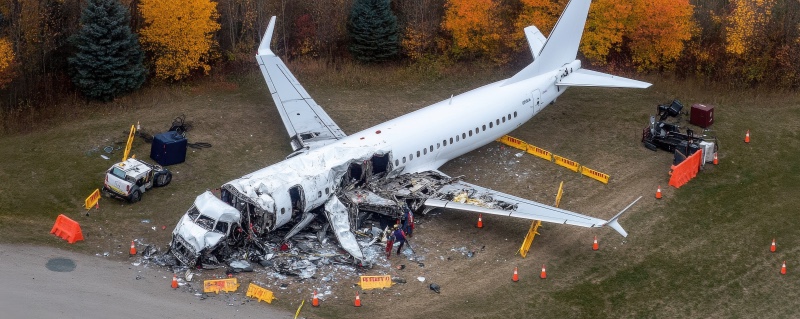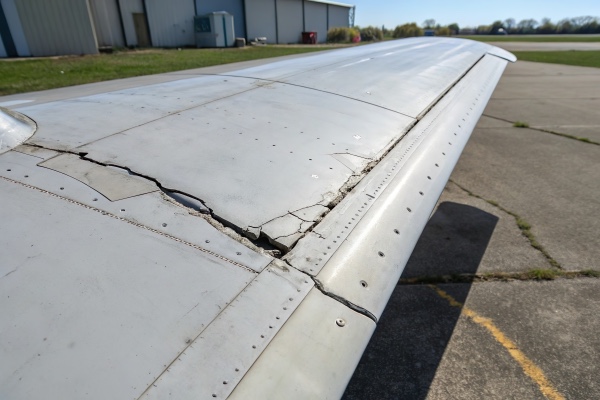
Table of contents
- Understanding Texas Airplane Accidents
- Overview of Federal Aviation Regulations
- Texas State Laws for Aviation Accidents
- Determining Liability in Airplane Accident Cases
- The Role of Federal Agencies in Accident Investigations
- How Jurisdiction Affects Your Aviation Accident Claim
- Steps to Take Following an Airplane Accident in Texas
- How Can Branch & Dhillon, P.C. Help With Your Airplane Accident Case?
- Additional Resources:
When it comes to travel, flying is considered one of the safest modes of transportation. However, recent accidents taking over news headlines have painted a clear picture of the terrible reality of when an airline accident does occur.
Here are just a few of the recent accidents that have occurred since the beginning of this year:
- January 29th, 2025: American Airlines aircraft collided with an Army Helicopter over the Potomac River killing 67 people.
- February 6th, 2025: A commuter plane in Alaska crashed, killing 10 people and leaving wreckage in the Bering Sea.
- February 10th, 2025: Private jet veered off the runway at Scottsdale Municipal Airport killing the pilot and four passengers.
- February 12th, 2025: An EA-18G Growler crashed into the San Diego Bay; the two Navy pilots were able to eject before impact.
- February 17th, 2025: Delta flight crashed while landing at Toronto Pearson International Airport, leaving 15 people injured.
From severe injuries to death, airplane accidents leave not only the victims’ lives in shambles but also those of their families. Branch & Dhillon, P.C. is dedicated to ensuring that individuals injured in an airplane accident have access to experienced legal counsel and guidance to aid them in getting the compensation they deserve from the liable party. Our attorneys thoroughly understand the complexity surrounding airplane accidents, as the intricate design of these modern marvels creates a complicated legal battle ahead when determining the negligent party and seeking out compensation. Additionally, federal laws and Texas state laws can also make seeking compensation challenging.
To honor our commitment to serving our community to the best of our abilities, your trusted airplane accident attorneys at Branch & Dhillon, P.C. have created this guide on how federal and Texas State laws affect an airplane accident case. Here is what you need to know:
Understanding Texas Airplane Accidents
How an individual seeks compensation for their injury or the wrongful death of a loved one after an aviation accident will depend on what type of aviation accident it is. Here are the most common types of airplane accidents:
- Commercial airplane accidents
- Private or charter plane accidents
- Helicopter accidents
- Airport ground Accidents
What Causes Airplane Accidents?

Knowing the cause of an airplane accident is crucial for seeking out compensation for any resulting injuries or wrongful death, as it helps establish the liability of the negligent party. Common causes are as follows:
- Pilot Error: This can include misjudging weather conditions, misreading instruments, failing to follow proper procedure, and poor decision-making during critical phases of flight such as takeoff and landing.
- Air Traffic Control Errors: These mistakes can include miscommunication with pilots, improper instructions, and failure to maintain safe separation between aircraft.
- Maintenance Errors: These errors include engine malfunctions, structural problems, landing gear failure, and avionics malfunction.
- Poor Weather Conditions: Poor weather conditions can be a significant problem for aircraft. Weather-related causes for plane accidents include: thunderstorms, strong winds, low visibility due to fog or heavy precipitation, or icy conditions.
- Pilot Fatigue: Fatigue can lead to poor decision-making or impair a pilot’s performance. Fatigue is often caused by long working hours, stress, and substance use.
- Bird Strikes: One of the least common causes of aviation accidents, birds can collide with airplanes, leading to damage to engines, windshields, or other parts of the aircraft.
- Runway Incursions: Unauthorized entry of aircraft, vehicles, or individuals on the runways.
- Sabotage or Terrorism: Intentional acts intended to cause catastrophic harm.
- Technological failures: Problems with flight management systems or software bugs that can cause an accident to occur due to improper readings or directions.
Overview of Federal Aviation Regulations
Two major laws govern personal injury claims against the Federal Aviation Administration (FAA). These two laws are the Federal Tort Claims Act and 14 CFR Part 15.
Federal Tort Claims Act
This act is the statute that governs lawsuits against the federal government. To sue the FAA, an individual must file an administrative claim with the FAA first. The file claim form is called Form 95. Once the form is filled out, the FAA will review it and either accept the claim or deny it. If the claim is accepted, then the FAA will pay compensation to the injured party. However, if it is denied, then the injured party may sue the FAA in federal court for damages.
14 CFR Part 15
These regulations apply to claims made under the Federal Tort Claims Act. It allows the injured party to make amendments to their claim for damages claimed against the United States for injury, loss of property, or for personal injury or wrongful death, caused by the negligence or wrongful act of an employee working for the FAA at the time of the accident. The amendments must be made before the final FAA action. It also makes it possible for the claimant to claim that the agency failed to make a final disposition of their claim if the FAA does not make a response within 6 months of the claim being filed.
Texas State Laws for Aviation Accidents

While some states have written special laws that apply specifically to damages caused by an airplane accident, Texas does not. It uses the same laws for plane accidents as it does for any other claims for damages that were caused by the negligent action of another.
Texas follows a modified comparative liability statute for all of its personal injury cases. This means individuals who were injured by the accident can bring lawsuits to recover their damages, even if they were partially responsible for the accident. This only applies to individuals who are at most 50% responsible for the accident.
When it comes to airplane accidents, there are many parties involved who could potentially become injured. This includes the passengers on the plane, the flight attendants, and the pilot. Because of this, depending on what caused the accident, all three categories of people on the plane could potentially sue for damages. Here is an example:
A pilot is following the instructions from flight control to take off by using runway B. However, runway B has been poorly maintained, resulting in some potholes scattered down the length of the runway. The pilot doesn’t know about the condition of the runway and follows orders. The front wheels of the plane, which were already showing signs of wear, hit one of the potholes, resulting in damage that was missed by the pilot. As they come in for the landing, the pilot makes a mistake, resulting in the plane landing awkwardly on the weakened wheel, causing the plane to crash. This resulted in injury to some of the passengers and two of the flight attendants.
After a thorough investigation, the cause of the accident was blamed partially on the condition of the runway, another part due to the poor condition of the aircraft, and the last part due to the poor performance of the pilot. The breakdown of fault is as follows: 50% due to the condition of the runway; 40% due to the condition of the aircraft; and 10% due to the pilot’s error. Because the pilot is only 10% responsible for the accident, he can seek compensation to cover 90% of the damages because the airport and the airline’s maintenance team were found to be at fault.
Determining Liability in Airplane Accident Cases
Determining liability in airplane accident cases can be extremely difficult as there are often multiple parties involved. Common parties that are typically involved in an airplane accident case are as follows:
- Pilots
- Flight Attendants
- Airline Companies
- Airplane Owner
- Airline Mechanics and Maintenance Staff
- Aircraft Manufacturers
- Airports
The Role of Federal Agencies in Accident Investigations

After an aviation accident, the National Transportation Safety Board (NTSB) will investigate to determine the cause of the accident. This organization was created to investigate all civil aviation accidents in the United States. In rare cases, the FBI or the Federal Aviation Agency will also play a role in determining the cause of the accident. However, these investigations, especially when the damage is extensive, can take months to years to complete. The most common causes of aircraft accidents include:
- Defective components
- Piloting errors
- Air traffic control errors
- FAA regulation violation
- Improper maintenance of the aircraft or runway
Liability for the accident will be established based on what caused the accident and whether that cause was tied to the negligence of one of the parties; airline, aircraft manufacturer, maintenance crew, pilot, or air traffic control.
What Legal Claims Can Be Made After an Airline Accident?
The legal claim that the injured party raises will depend on the nature of the accident. These are among the most common:
- Negligence/personal injury cases: the plaintiff must show that the defendant owed them a duty of care, the defendant breached that duty, and it was the breach of duty that led to the accident and the plaintiff’s injuries.
- Strict Liability: In product liability cases, the manufacturer may be found strictly liable for putting a dangerous product on the market.
- The Federal Tort Claims Act: Allows private citizens to sue the federal government and its employees for torts committed in the scope of their employment.
- Respondent Superior: The employer, in some cases, may be responsible for the actions of their employee.
- Texas Tort Claims Act: This is Texas’s version of the Federal Tort Claims Act that allows Texas citizens to sue the state government and its employees for negligence committed in the scope of their employment. For this to apply, the employee must have been acting within the description of their job and it must be determined that they would have been found liable if they had been a private individual.
How Jurisdiction Affects Your Aviation Accident Claim
In an airplane accident, the jurisdiction, or the court’s authority to hear a case, is vital. IOt determines where the lawsuit can be filed and which laws apply, whether state or federal. This will influence the outcome of the claim. Factors that play into where the jurisdiction will lie include:
- Where the accident took place
- The party’s residence
- Where the airline is headquartered at
Steps to Take Following an Airplane Accident in Texas

If you have been injured in an aviation accident, you will want to take the following steps:
- Seek out medical attention: This will ensure that any injuries are properly treated and create documentation about your injuries and the proposed treatment plan.
- Gather documentation: This includes the following:
- Documentation about your injuries and treatment plan
- Out-of-pocket expenses concerning your injuries or new accommodations
- Communication with the airline or their insurance companies
- Contact an airplane accident attorney.
- Do not sign or speak with the airline or the insurance companies without your attorney present.
- Do not make public statements or social media posts about the accident.
How Can Branch & Dhillon, P.C. Help With Your Airplane Accident Case?
The aviation accident attorneys at Branch & Dhillon can help you navigate the complexities of your case and ensure that you get the compensation you deserve. We do this by:
- Investigating your case: We work with aviation experts and accident reconstruction specialists to figure out what caused the crash.
- Establish liability: Our team will help you pinpoint the liable party to ensure you can get the compensation you deserve.
- Ensure you understand the complex regulations: Aviation law involves federal regulations and Texas state law. Our attorneys will ensure that you know the nuance of these laws and how they may impact your case.
Don’t let an airplane accident signal the end of your bright future. Instead, reclaim control of your life by contacting the personal injury attorneys at Branch & Dhillon, P.C. today.

